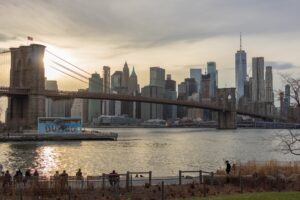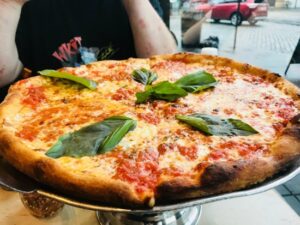DUMBO: NYC’s Instagrammable Wonderland

Your Guide to Exploring an Immersive Living Postcard
Picture a neighborhood with gorgeous skyline views, cobblestone streets embedded with railroad tracks, docks and piers, and vestiges of a long-gone industrial powerhouse. Where, in the course of the last few decades, this abandoned manufacturing district would be the transformative canvas against which thriving art, technology and small business communities would converge, converting empty factories and warehouses into stratospherically-priced residential and commercial living spaces. Long ago, the neighborhood carried historic names lake “Rapailie”, “Olympia”, “Fulton Landing” and “Gairville”. But it is now famously called DUMBO (acronym for “Down Under the Manhattan Bridge Overpass”) — a legendary name that not only gives a hint to its location, but brings us back to the 1970s when a group of low-income artists, in adopting the desolate area as home, coined the moniker to dissuade developers from touching its then-gritty, deserted and isolated grounds.
But that hope for an under-the-radar existence would be short-lived. Bounded by Brooklyn Bridge Park to the north, the Brooklyn Bridge to the west, Brooklyn Heights to the south and Vinegar Hill to the east, the relatively small 32-acre district would be purchased in 1979 by real estate developer David Walentas for $12M — a steal at $6/sq. ft. Before long, DUMBO’s derelict industrial spaces would take on new life as luxury lofts and creative hubs — magnetic attractions for anyone wishing to partake in the low-key neighborhood’s galvanizing undercurrents that seem to indicate a perpetual resurgence of change.
Here we give an overview of DUMBO’s many industrial, technological and creative cultures over time.
About its Industrial History …
In the mid-1800s, as the Industrial Revolution took off, this area was known to produce many Brooklyn-born inventions we now take for granted. Many of the buildings stored coffee (Arabica Coffee), sugar (Domino’s), corrugated boxes (Robert Gair Co.), scouring pads (Brillo Manufacturing Co.) and other products for the city (water meters, et, al.)
In the wave of deindustrialization which accelerated after World War II, many industries left the city. With the construction of the Brooklyn-Queens Expressway (BQE) in the 1950s further isolating the district, the creation of slums caused a steady downfall lasting for about 40 years. Walentas’ $12M purchase for the 32-acre district in 1979 would prove a catalytic, epoch-changing event for the industrial wasteland. In 1981, his Two Trees company bought several properties with a vision of highlighting arts and culture as an integral player in the development of the neighborhood and its waterfront.
About its Tech Revolution …
The tech boom of the late 1990s helped fuel DUMBO’s growth, as Manhattan’s rising rents made Brooklyn’s relatively lower costs more attractive to an influx of entrepreneurs who sought the kinds of spaces DUMBO could offer. In 2005, for example, Etsy’s founders created their online marketplace in a Brooklyn apartment. Today, with DUMBO currently having the city’s highest concentration of pioneering and fast-growing technology firms (it is home to 25% of New York-based tech firms and startups), the neighborhood’s residents are primarily young professionals in the industry. Distinguished for innovation and affluence, DUMBO is known for its high-end loft spaces, upscale restaurants, trendy cafes and pricy independent businesses.
About its Creative Renaissance and Attractions …
While DUMBO is usually among the priciest of Brooklyn neighborhoods, it has many treasures to share with all locals and visitors alike, many of them either free or within affordable range! Here we provide a guide to some of our favorite adventures:
 Where to Instagram those iconic skyline views …
Where to Instagram those iconic skyline views …
- Ride the East River Route of the NYC Ferry from-or-to Manhattan/Dumbo
- Walk across the Brooklyn Bridge
- Stroll along Brooklyn Bridge Park’s waterfront promenade
- Selfie with the Manhattan Bridge, at the corner of Water and Washington Streets, TripAdvisor
- Make your way to the rooftop of the TimeOut Market
 Where to eat …
Where to eat …
- Savor a pizza from Juliana’s or Grimaldi’s or Ignazio’s
- Munch your way through the amazing food choices at the TimeOut Market
- Grab a treat at Jacques Torres Chocolate Shop
- Splurge and enjoy fine dining with amazing views at The River Café
- Enjoy an ice-cream scoop at Ample Hills Creamery
- Have a cozy dinner at Vinegar Hill House
Where to drink …
- Take instragrammable libations from Harriet’s Rooftop Cocktail Lounge
- Try the signature cocktails of TimeOut Market’s Rooftop Bar
- Browse more from this roster of recommendations for best bars in DUMBO, Link
Where to explore history …
- Explore the Brooklyn Historical Society’s DUMBO location at the Empire Stores
- Relive perpetual childhood with an old-fashioned ride on vintage Jane’s Carousel
- See the Jay Street Connecting Railroad Tracks remnants of railroad system to warehouses
- See the DUMBO Walls created by artists in 2012
- Visit St. Anne’s Warehouse, a former tobacco factory transformed into a state-of-the-art performance space.
Where to read more …
- Brooklyn Guide: Things to do in DUMBO, Link
- Brooklyn Ink: How did Dumbo become Dumbo? The Story of a Neighborhood, Link
We welcome you to join us for our Half Day Brooklyn Walking Tour to dig deeper into the narratives of DUMBO and its neighboring historic districts. You will come away with an appreciation for how this former industrial wasteland is now a much sought-after destination.